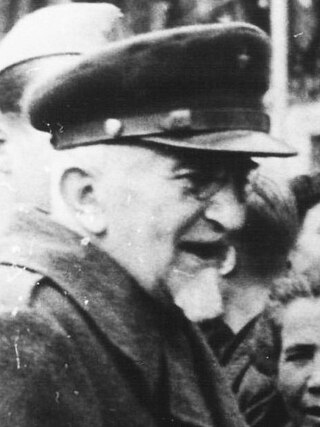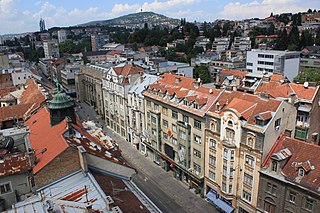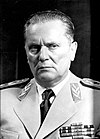
Josip Broz, commonly known as Tito, was a Yugoslav communist revolutionary and politician who served in various positions of national leadership from 1943 until his death in 1980. During World War II, he led the Yugoslav Partisans, often regarded as the most effective resistance movement in German-occupied Europe. Following Yugoslavia's liberation in 1944, he served as its prime minister from 2 November 1944 to 29 June 1963 and president from 14 January 1953 until his death in 1980. The political ideology and policies promulgated by Tito are known as Titoism.

Vladimir Nazor was a Croatian poet and politician. During and after World War II in Yugoslavia, he served as the first President of the Presidium of the Croatian Parliament, and first Speaker of the Croatian Parliament.

Vrbas is a town and municipality located in the South Bačka District of the autonomous province of Vojvodina, Serbia. As of 2022, the town has a population of 20,892, while the municipality has 36,601 inhabitants.
Nama, or NAMA, is the acronym for Narodni magazin 'national store'. This was a chain of department stores in the former SFRY (Yugoslavia) and the first Slovenian department store. Nama owns three stores in Slovenia today:

Čop Street is a major pedestrian thoroughfare in the center of Ljubljana, Slovenia and regarded as the capital's central promenade.

Varadin Bridge is a bridge over the Danube river in Novi Sad, Vojvodina, Serbia. The current bridge built in 2000, replaced the original bridge destroyed during NATO bombardment on 1 April 1999.

Ban Jelačić Square is the central square of the city of Zagreb, Croatia, named after Ban Josip Jelačić. The official name is Trg bana Josipa Jelačića. The square is colloquially called Jelačić plac.
Novi Sad is one of the most important Serbian centers of higher education and research, with four universities, numerous professional, technical, and private colleges, and a couple of research institutes.
Stari Aerodrom is a neighbourhood in the city of Podgorica that borders the neighborhoods of Ribnica, Vrela Ribnička, Drač and Tuški put. The neighbourhood is located beside an old military airport, Ćemovsko Polje Airport, hence the name "Stari Aerodrom". It is one of three neighbourhoods that comprise the Konik suburb, as well as one of the few neighbourhoods that have seen a large construction boom.

Zois Mansion is a mansion in Ljubljana, the capital of Slovenia. It stands in the Center District, at Breg, a street on the west (left) bank of the Ljubljanica, between Teutonic Street to the north and Zois Street to the south. The mansion served as residence of Baron Sigmund Zois, a leading figure of Enlightenment in the Slovene Lands of the Austrian monarchy and supporter of the revival of Slovene culture and literature.

The Praetorian Palace is a 15th-century Venetian Gothic palace in the city of Koper, in southwest Slovenia. Located on the southern side of the city's central Tito Square, it houses the Koper city government and a wedding hall. It is considered one of the city's architectural landmarks.
Aleksandar "Mišo" Broz is a Croatian retired diplomat. He is the youngest son of Yugoslav president and Marshal Josip Broz (1892–1980) and Herta Haas (1914–2010).

Republic of Croatia Square is one of the biggest squares in Zagreb, Croatia. The square is located in Lower Town, with the Croatian National Theatre building at its centre. It is sometimes billed as the "most beautiful square in Zagreb".
The Tito Street decision refers to a landmark October 2011 Constitutional Court of Slovenia ruling U–I–109/10, in which the court found that the April 2009 naming of a street in Slovenia's capital Ljubljana after Josip Broz Tito was unconstitutional. The court unanimously ruled that "the name Tito does not only symbolise the liberation of the territory of present-day Slovenia from fascist occupation in WWII as claimed by the other party in the case, but also grave violations of human rights and basic freedoms, especially in the decade following WWII." This was the first time that a highest national court legally evaluated the symbolism of Josip Broz Tito's name.

Vladimir Šterk was a well-known Croatian architect.

The Lenuci Horseshoe or the Green Horseshoe is a U-shaped system of city squares with parks in downtown Zagreb, Croatia. The horseshoe was conceived in 1882 by Croatian urbanist Milan Lenuci. The parks were designed between 1883 and 1887, at a time when today's Donji grad formed the southern outskirts of Zagreb. The construction was helped by the efforts to rebuild the city after the 1880 Zagreb earthquake, and in 1889 the entire horseshoe was finished—its two ends were connected by the newly built Zagreb Botanical Garden. The park system consists of seven squares aligned on three straight lines.

Stevan Kragujević was a Serbian photojournalist and art photographer.
Ivan Srebrenjak or Srebrnjak ran a Soviet intelligence network for the NKVD in the Balkans at the beginning of Axis occupation of Yugoslavia.

Marshal Tito street, or Tito's street, is one of the main streets in Sarajevo, located in the Centar Municipality. The street is named after Josip Broz Tito, the former President of Yugoslavia.























